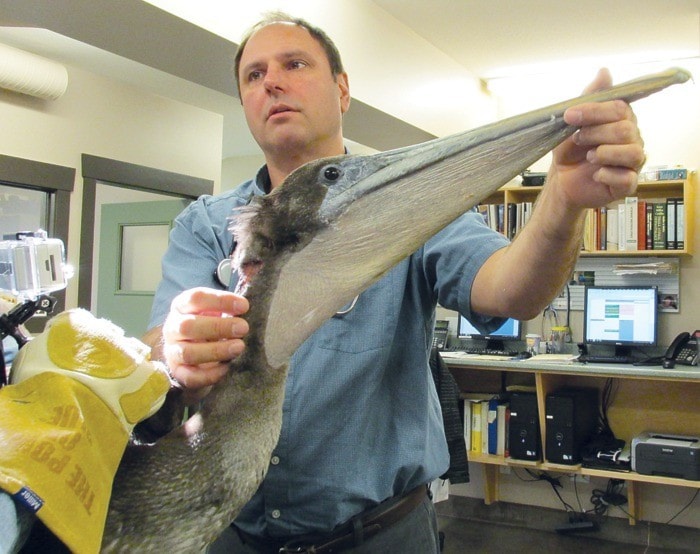Six years ago I had my first “up close and personal” experience with a very unique bird.
Gregarious and comical by nature, the brown pelican is an endearing bird that is quite at home around people. These pelicans are found along the southern reaches of the eastern and western seaboards of North America. Migration takes them from southern California to Mexico and as far south as Chile; their summer boundary is usually off the coastline of southern Vancouver Island.
One of seven species, brown pelicans prefer shallow water along the coastline and rarely venture more than 20 miles off shore. They usually roost on sandbars and spits but are quite at home on docks, piers or pylons, and recently a flock was seen in Victoria’s inner harbour. Waddling clumsily from side to side when walking on land they become extremely graceful in flight gliding above the water in search of food.
Brown pelicans are large stocky birds that weigh between 3 and 5 kilograms. They have long wings, short legs and tails. Their best known feature is their huge beak that is well known for its “gular pouch” which hangs off the lower mandible and is used as a huge expandable fishing net. This elastic pouch truly can “hold more than its belly can,” holding up to 10 litres of water and fish.
The pelican will tuck its wings back against its body and dive like a torpedo into the water. Extra air sacks under the skin of their bellies absorbs the impact with the water. Air pockets in its bones makes the pelican extremely buoyant and the bird is able to pop back up to the surface with its catch.
Once the pouch is drained of water the head is thrown backwards and the fish swallowed. The pouch is also used as an air conditioner in hot weather, the moistened pouch is fluttered cooling down the body temperature.
Brown pelicans will also beat their wings on the water whilst swimming in a circular formation, herding the fish into shallow water where they are scooped up from the surface into the pouch. Favorite fish for the pelicans are anchovies, sardines and herring.
Populations of brown pelicans have fluctuated over the last few decades. They were on the endangered species list mainly due to DDT and other pesticide poisoning which was especially hard on their reproduction.
Although Mountainaire Avian Rescue Society (MARS) has not had a brown pelican in care since 2006 there have been yearly sightings along the shores of Vancouver Island and the indications certainly point towards climate change as the reason. It is normal for the pelicans to follow the food source which also head north to our area but with cooler late spring temperatures and longer dry summers and fall the balance is definitely changing the habits of different animal and bird species.
The relentless storms that have lashed our area in the last few weeks obviously caught the small flock of pelicans off the coast of southern Vancouver Island which were seen in Victoria and another single bird was rescued in Tofino and brought to our center.
This pelican was not only starving but had sustained some significant injuries to its head and pouch. A special thanks to Dr. Stacey Gastis for treating the pelican.
It looks like we will have the latest pelican for a while as his injuries will take time to heal, we will need to use a lot more resources for this semi tropical bird.
If you would like to help sponsor this bird through a “Christmas gift” please call our center @ 250-337-2021 or visit our web site, www.wingtips.org.
